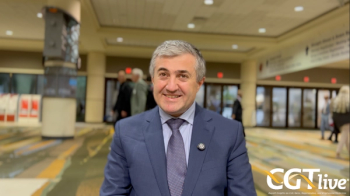
Autologous Adipose Stem Cells Safe in Alzheimer Disease, More Efficacy Data Needed
Autologous adipose stem cell data in a small cohort provides a feasibility for future validation studies.
This content originally appeared on our sister site,
Intravenous administration of autologous adipose stem cells (ADSCs) was safe and reduced amyloid-ß in a relatively small cohort of patients with Alzheimer disease (AD), according to data presented at the
ADSCs have neprilysin activity, an amyloid-ß-degrading enzyme, and investigators assessed effects on cognitive function and changes in amyloid-ß and p-tau. Senior author Hisakazu Yamagishi, MD, Department of Digestive Surgery, Kyoto Prefectural University of Medicine, tested the safety of ADSCs in a small cohort of 3 patients with AD.
Each patient had between 5x107 and 9x107 ADSCs administered intravenously 5-6 times at 1-month intervals, along with neurological examinations, cognitive function assessments, and interviews being conducted at the same time points. Safety was observed for at least 3 months after the last dose.
At the conclusion of the study, no adverse events, including any abnormal changes in blood laboratory values, were observed. All patients were conscious, ambulatory, showed no depressive tendencies, and even began to go back to some of their normal activities of daily living. One patient began to work in a field near his house, which he had been previously unable to do, and was able to return home by himself from the field without wandering. Another recalled being in a sorority in school, and the third did not show signs of worsened condition, according to their family.
READ MORE:
"Although amyloid antibodies have already made it possible to remove amyloid-β, amyloid-related imaging abnormalities (ARIA) may occur with antibody drugs, but ARIA is unlikely to occur with treatment with degrading enzymes, especially those that are naturally present in the body, and in fact no case has been reported to date,” the study authors wrote.1 "Another possible advantage over antibody therapy is that antibody therapy only reacts to specific proteins, whereas stem cells may react to several abnormal proteins."
At baseline, the Montreal Cognitive Assessment (MoCa) scores were 10, 5, and 3, in each patient, respectively. Following each ADSC treatment, the MoCa scores changed from 19, 23, 23, 22, 22, and 20 in case 1, 5, 8, 6, 7, 8, and 10 in case 2, and 5, 7, 8, 9, 11, and 7 in case 3. Using PET, amyloid-ß was decreased in 1 patient, showed almost no change in another, and increased in the other patient.
Despite the lack of control group and small sample size, investigators concluded that the MoCa and interview results suggest this treatment is promising. They went on to write, "the reduction in amyloid-β, even in one case, may also be of some significance. In addition, it is interesting to note that the change in p-tau corresponded to the change in amyloid-β. ADSCs may enter the brain and affect both amyloid-β, which is deposited outside neurons, and p-tau, which is deposited inside neurons. Cognitive function may be improved by ADSCs administration. However, changes in cognitive function may not necessarily be related to amyloid-β or p-tau deposition."
The use of autologous cellular therapy has become somewhat of a trend within neurology in recent years, most notably in multiple sclerosis (MS) and amyotrophic lateral sclerosis (ALS). Most recently, research showed that bone marrow-derived mesenchymal stem cells
For more coverage of CTAD 2021,
REFERENCES
1. Shigematsu K, Ishii K, Komori N, Tahara K, Yamagushi H. Repeated administration of autologous adipose tissue-derived stem cells improved cognitive function in Alzheimer disease. Presented at CTAD 2021; November 9-12. Poster P8
2. Tavakol-Afshari J, Boroumand AR, Farkhad NJ, Moghadam AA, Sahab-Negah S, Gorji A. Safety and efficacy of bone marrow derived-mesenchymal stem cells transplantation in patients with amytrophic lateral sclerosis. Regen Ther. Published online August 16, 2021.
3. BrainStorm announces positive topline data in phase 2 study evaluating NurOwn as a treatment for progressive MS. News release. BrainStorm Cell Therapeutics. March 24, 2021. Accessed November 11, 2021. https://www.prnewswire.com/news-releases/brainstorm-announces-positive-topline-data-in-phase-2-study-evaluating-nurown-as-a-treatment-for-progressive-ms-301254709.html
Newsletter
Stay at the forefront of cutting-edge science with CGT—your direct line to expert insights, breakthrough data, and real-time coverage of the latest advancements in cell and gene therapy.

















































